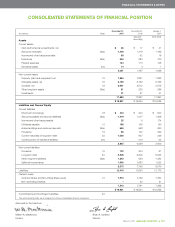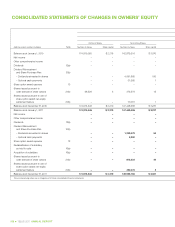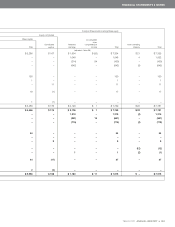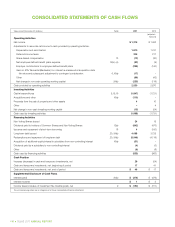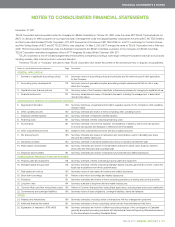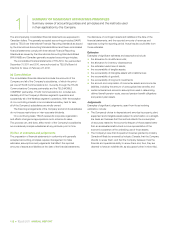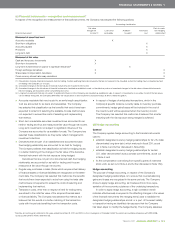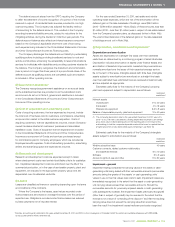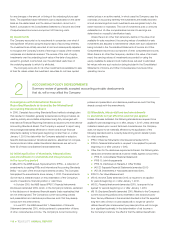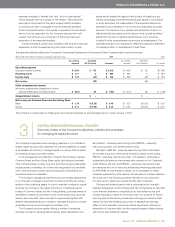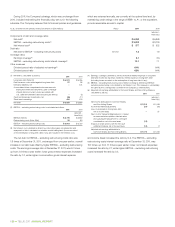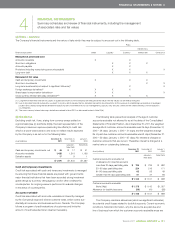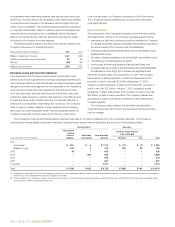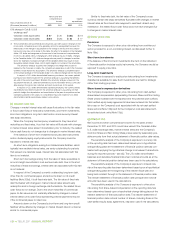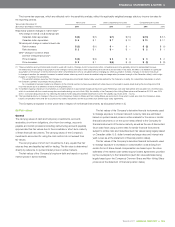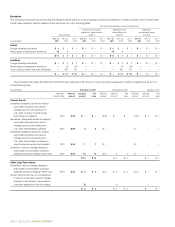Telus 2011 Annual Report Download - page 120
Download and view the complete annual report
Please find page 120 of the 2011 Telus annual report below. You can navigate through the pages in the report by either clicking on the pages listed below, or by using the keyword search tool below to find specific information within the annual report.116 . TELUS 2011 ANNUAL REPORT
Impairment – property, plant and equipment; intangible assets
subject to amortization
The continuing program of asset life studies considers such items as
timing of technological obsolescence, competitive pressures and future
infrastructure utilization plans; such considerations could also indicate
that carrying values of assets may not be recoverable. If the carrying
values of assets were not considered recoverable, an impairment loss
would be recorded.
Impairment – intangible assets with indefinite lives; goodwill
The carrying values of intangible assets with indefinite lives and goodwill
are periodically tested for impairment. The frequency of the impairment
tests generally is the reciprocal of the stability of the relevant events and
circumstances, but intangible assets with indefinite lives and goodwill
must, at a minimum, be tested annually; the Company has selected
December as its annual test time.
The Company assesses its intangible assets with indefinite lives
by comparing the recoverable amounts of the cash-generating units
to the carrying amounts of its cash-generating units (including the
intangible assets with indefinite lives allocated to the cash-generating
unit, but excluding any goodwill allocated to the cash-generating unit).
To the extent that the carrying values of the cash-generating units
(including the intangible assets with indefinite lives allocated to the
cash-generating unit, but excluding any goodwill allocated to the cash-
generating unit) exceed their recoverable amounts, the excess would
reduce the carrying value of intangible assets with indefinite lives.
Subsequent to assessing its intangible assets with indefinite lives,
the Company then assesses its goodwill by comparing the recoverable
amounts of the cash-generating units to the carrying amounts of
its cash-generating units (including the intangible assets with indefinite
lives and the goodwill allocated to the cash-generating unit). To the
extent that the carrying values of the cash-generating units (including
the intangible assets with indefinite lives and the goodwill allocated to
the cash-generating unit) exceed their recoverable amounts, the excess
would first reduce the carrying value of goodwill and any remainder
would reduce the carrying value of the assets of the cash-generating
unit on a pro-rated basis.
The Company has determined that its current cash-generating units
are its reportable segments, Wireless and Wireline, as the reportable
segments are the smallest identifiable groups of assets that generate
net cash inflows that are largely independent of each other.
(k) Translation of foreign currencies
Trade transactions completed in foreign currencies are translated into
Canadian dollars at the rates prevailing at the time of the transactions.
Monetary assets and liabilities denominated in foreign currencies are
translated into Canadian dollars at the rate of exchange in effect at
the statement of financial position date with any resulting gain or loss
being included in the Consolidated Statements of Income and Other
Comprehensive Income as a component of Financing costs, as set out
in Note 8. Hedge accounting is applied in specific instances as further
discussed in Note 1(d).
The Company has minor foreign subsidiaries that do not have
the Canadian dollar as their functional currency. Accordingly, foreign
exchange gains and losses arising from the translation of the minor
foreign subsidiaries’ accounts into Canadian dollars are reported as a
component of other comprehensive income, as set out in Note 10.
(l) Income taxes*
The Company follows the liability method of accounting for income taxes.
Under this method, current income taxes are recognized for the estimated
income taxes payable for the current year. Deferred income tax assets
and liabilities are recognized for temporary differences between the tax
and accounting bases of assets and liabilities, as well as for the benefit
of losses and Investment Tax Credits available to be carried forward to
future years for tax purposes that are more likely than not to be realized.
The amounts recognized in respect of deferred income tax assets and
liabilities are based upon the expected timing of the reversal of temporary
differences or usage of tax losses and application of the substantively
enacted tax rates at the time of reversal or usage.
The Company accounts for changes in substantively enacted tax
rates affecting deferred income tax assets and liabilities in full in the
period in which the changes were substantively enacted; the Company
has selected this method as its emphasis on the statement of financial
position is more consistent with the liability method of accounting for
income taxes. The Company accounts for changes in the estimates of
prior year(s) tax balances as estimate revisions in the period in which
the changes in estimate arose; the Company has selected this method
as its emphasis on the statement of financial position is more consistent
with the liability method of accounting for income taxes.
The operations of the Company are complex and the related tax
interpretations, regulations and legislation are continually changing.
As a result, there are usually some tax matters in question that result in
uncertain tax positions. The Company only recognizes the income tax
benefit of an uncertain tax position when it is more likely than not that the
ultimate determination of the tax treatment of the position will result in
that benefit being realized. The Company accrues for interest charges
on current tax liabilities that have not been funded, which would include
interest and penalties arising from uncertain tax positions. The Company
includes such charges in the Consolidated Statements of Income and
Other Comprehensive Income as a component of Financing costs.
The Company’s research and development activities may be eligible
to earn Investment Tax Credits; the determination of eligibility is a
complex matter. The Company only recognizes Investment Tax Credits
when there is reasonable assurance that the ultimate determination
of the eligibility of the Company’s research and development activities
will result in the Investment Tax Credits being received. When there
is reasonable assurance that the Investment Tax Credits will be received,
they are accounted for using the cost reduction method whereby such
credits are deducted from the expenditures or assets to which they
relate, as set out in Note 9.
(m) Share-based compensation
For share option awards granted after 2001, a fair value is determined
for share option awards at the date of grant and that fair value is recog-
nized in the financial statements. Proceeds arising from the exercise of
share option awards are credited to share capital, as are the recognized
grant-date fair values of the exercised share option awards.
Share option awards which have a net-equity settlement feature, as
set out in Note 13(b), and which do not also have a net-cash settlement
feature, are accounted for as equity instruments. The Company has
selected the equity instrument fair value method of accounting for the
net-equity settlement feature as it is consistent with the accounting
treatment afforded to the associated share option awards.
*Denotes accounting policy affected in the years ended December 31, 2011 and 2010, by the convergence of Canadian GAAP for publicly accountable enterprises with IFRS-IASB,
as discussed further in Note 2 and Note 25.



